Phono Cartridges Explained
A phono cartridge is a small electro-mechanical component mounted at the front of a tonearm on a turntable. There are two main sections, the cartridge body houses the wire coils that generate the electrical signals which are then transfered via the tonearm wires to the phono stage in the amplifier. The stylus assembly consists of a plastic moulding with a cantilever (or tube) and stylus (or needle) which vibrates as it traces the record grooves. The stylus is the needle shaped tip of diamond at the front end of the cantilever. (Note: A cartridge when purchased comes with the stylus assembly. Most cartridges are designed with a stylus assembly that is end-user replaceable.)
The performance potential of a record playing system is defined by the capabilities of the phono cartridge. Tonal balance, response range, clarity on musical peaks, stereo separation and imaging, and freedom from noise and distortion are all affected at the outset. The selection of this first component is critical to the full enjoyment of the rest of your system. The cartridges fitted to most common turntables from the 70s and 80s (eg Japanese brands) are basic models and most are capable of improved sound quality by installing a better cartridge (which comes with a higher quality stylus).
If you are interested in upgrading to a better cartridge please have a look at our Phono Cartridges category or for a broader selection go to our sister site http://www.decibelhifi.com.au/phono-cartridges-moving-magnet/ where there are also additional brochures and guides.
Cartridge Mount
A cartridge is designed to be mounted on a turntable's tonearm. Some tonearms use a universal headshell. Others use a P-mount. A lesser number use a proprietary mount. The latter means you are restricted to their design.
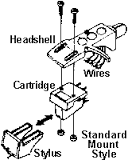 The half-inch mount or standard mount as it is sometimes called is probably the most common. As illustrated on the left, two screws located a half-inch apart are threaded through the cartridge body and secured to the headshell. Four wires, each of a different color, are attached to the male plugs at the rear of the cartridge body. The other end of these wires are attached to the headshell plugs.
The half-inch mount or standard mount as it is sometimes called is probably the most common. As illustrated on the left, two screws located a half-inch apart are threaded through the cartridge body and secured to the headshell. Four wires, each of a different color, are attached to the male plugs at the rear of the cartridge body. The other end of these wires are attached to the headshell plugs.
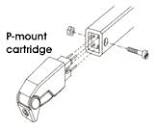 The P-mount or T4P, as illustrated on the left, utilizes a different approach. The cartridge is plugged into the tonearm and is then secured to the tonearm by a single screw.
The P-mount or T4P, as illustrated on the left, utilizes a different approach. The cartridge is plugged into the tonearm and is then secured to the tonearm by a single screw.
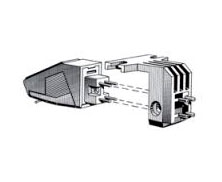 A universal cartridge is designed for use in either a half-inch or P-mount tonearm. A universal cartridge is simply a P-mount cartridge with a standard adapter.
A universal cartridge is designed for use in either a half-inch or P-mount tonearm. A universal cartridge is simply a P-mount cartridge with a standard adapter.
Generally, there are three different stylus tips:
Round (conical) tip
Most common, used on all ceramic and most magnetic styli.
Typically they are about 0.7mil in diameter for microgroove records such as normal LPs and 45s. A much larger (3.0 mil diameter tip is needed for playing 78s as the grooves are wider.
Elliptical tip
Available on some magnetic styli only. The smaller front to back diameter allows better tracking and sound reproduction (particularly of the inner grooves). A typical dimension is 0.7mil x 0.3mil.
Line Contact tip
There are numerous examples of this type of advanced shape stylus (fine-line, shibata, microline, parabolic, vital, microscanner, Fritz Geiger etc). Available only on a few, more expensive, magnetic styli. More faithfully reproduces the original recorded sound because the V shape sits more snugly in the grooves and record and stylus wear is reduced due to the increased area in contact with the vinyl.
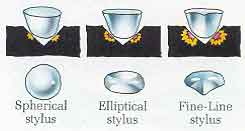
Stylus assembly types
For Ceramic cartridges.
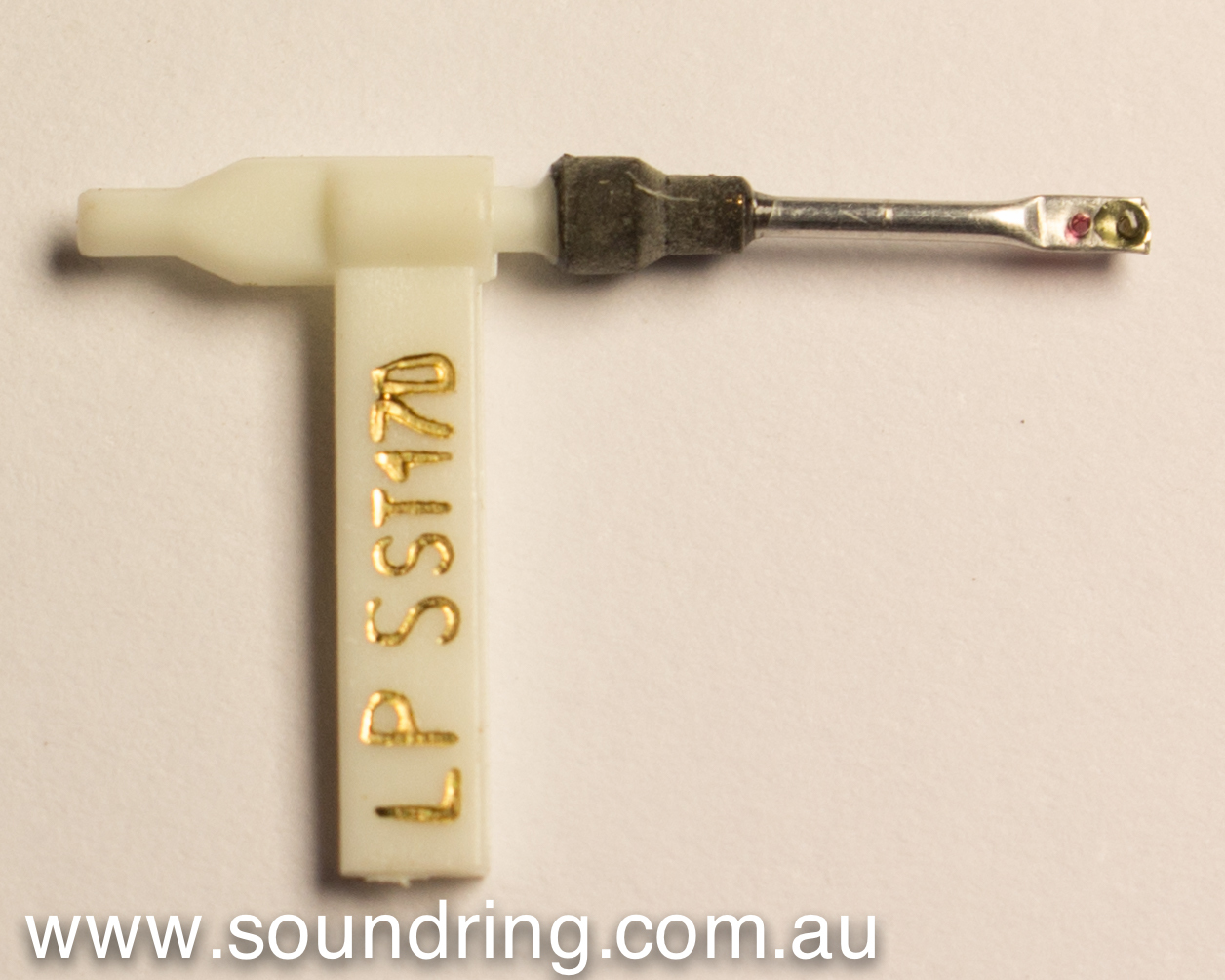 Normally held in position by a screw or metal clip.
Normally held in position by a screw or metal clip.
These are common in record players from the 60's. Originally the tips were Sapphire or Diamond but nowadays all are Diamond. Ceramic cartridges have limited frequency response compared to magnetic types, and the separation between channels is also less. They track at 4 to 7g which causes faster record wear also. The types of record players that use ceramic cartridges are not capable of high fidelity reproduction.
For Moving Magnet cartridges.
 Usually have a plastic moulding with a brass tube that pushes into the cartridge body. The cantilever (usually metal) sits in a rubbery suspension block and the diamond tip is mounted at the front end. Turntables using magnetic cartridges usually track at 1.0 to 4g.
Usually have a plastic moulding with a brass tube that pushes into the cartridge body. The cantilever (usually metal) sits in a rubbery suspension block and the diamond tip is mounted at the front end. Turntables using magnetic cartridges usually track at 1.0 to 4g.
